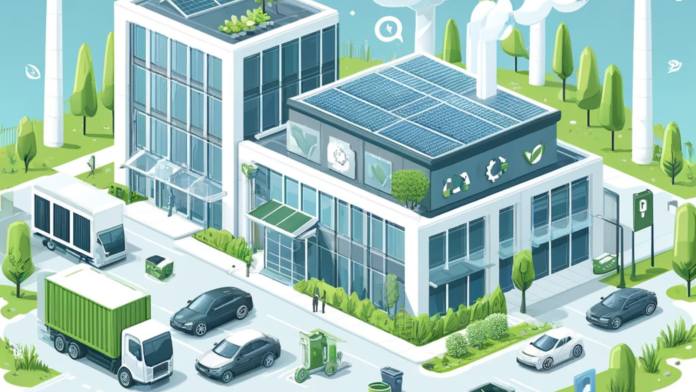As climate change becomes an increasingly urgent issue, companies around the world are stepping up their efforts to reduce their carbon footprint. For businesses, reducing greenhouse gas (GHG) emissions is not just about corporate social responsibility—it’s becoming a strategic imperative to meet regulatory requirements, manage risks, and appeal to environmentally conscious consumers. In this article, we’ll explore some of the innovative strategies companies are using to minimize their carbon footprint and contribute to a more sustainable future.
1. Switching to Renewable Energy
One of the most impactful ways companies are cutting their carbon emissions is by transitioning from fossil fuels to renewable energy sources like wind, solar, and hydropower. Many large corporations, including Google, Amazon, and Microsoft, have committed to using 100% renewable energy to power their operations.
Example:
Google became the first major company to achieve carbon neutrality in 2007 and has since committed to operating entirely on carbon-free energy by 2030. The company’s data centers, which require vast amounts of electricity, are powered largely by solar and wind energy, significantly reducing its carbon footprint.
2. Energy Efficiency Initiatives
Reducing energy consumption is a simple yet effective way to cut carbon emissions. Businesses are adopting energy-efficient practices in their offices, factories, and supply chains. These can include upgrading to energy-efficient lighting, heating, ventilation, and air conditioning (HVAC) systems, and optimizing manufacturing processes.
Example:
Unilever has invested heavily in energy efficiency across its global operations. The company has reduced its carbon emissions by implementing energy-saving projects like upgrading equipment, optimizing manufacturing processes, and deploying energy-efficient technologies in its factories.
3. Sustainable Supply Chain Management
Supply chains are a significant contributor to a company’s overall carbon footprint. To mitigate this, businesses are increasingly looking at ways to reduce emissions throughout their supply chains by working with suppliers who prioritize sustainability, sourcing materials locally, or switching to greener logistics and transportation options.
Example:
IKEA has implemented sustainable sourcing policies to ensure that 100% of the wood and paper used in its products come from certified sustainable sources. The company also invests in low-carbon transportation options, like electric vehicles, to reduce emissions from logistics.
4. Carbon Offsetting
For emissions that cannot be immediately eliminated, many companies are investing in carbon offsetting projects. These projects involve funding initiatives that either reduce or remove an equivalent amount of carbon dioxide from the atmosphere, such as reforestation, renewable energy projects, or carbon capture and storage technologies.
Example:
Delta Air Lines has committed to becoming the first carbon-neutral airline globally by investing in carbon offsetting projects. These projects include reforestation efforts, investments in renewable energy, and funding for carbon capture and sequestration technologies.
5. Adopting Circular Economy Practices
Many businesses are adopting circular economy principles to minimize waste and reduce carbon emissions. By designing products with longer lifespans, encouraging reuse, and promoting recycling, companies can cut down on the energy-intensive processes associated with manufacturing new products, which often contribute to high carbon emissions.
Example:
The clothing brand Patagonia has long been a leader in the circular economy by encouraging its customers to repair and reuse their products. Through its Worn Wear program, Patagonia buys back used clothing, repairs it, and resells it, significantly reducing the carbon footprint associated with producing new garments.
6. Electrification of Vehicle Fleets
For companies that rely on transportation, electrification is a powerful way to cut carbon emissions. Many businesses are transitioning to electric vehicles (EVs) for their delivery and logistics operations, which can significantly reduce emissions compared to traditional gasoline or diesel-powered vehicles.
Example:
Amazon has committed to reaching net-zero carbon emissions by 2040, and as part of this effort, the company ordered 100,000 electric delivery vans from Rivian, an electric vehicle startup. The rollout of these electric vans is expected to reduce Amazon’s carbon emissions from transportation.
7. Employee Engagement and Green Offices
Businesses are also looking inward and engaging employees in their sustainability initiatives. By promoting energy-efficient habits in the workplace, offering remote work options to reduce commuting emissions, and creating eco-friendly office spaces, companies are reducing their carbon footprint internally.
Example:
Salesforce has introduced multiple green office initiatives, including energy-efficient buildings, waste reduction programs, and encouraging remote work to reduce the need for office space and commuting. Additionally, Salesforce’s “Sustainability Cloud” tool helps companies track and reduce their carbon emissions.
8. Carbon-Neutral Products
Some companies are going a step further by offering carbon-neutral products. This involves reducing emissions in the production process and offsetting any remaining emissions, making the entire product lifecycle carbon neutral.
Example:
Apple has committed to making all of its products carbon-neutral by 2030. The company is working to reduce emissions across its entire supply chain, including manufacturing, shipping, and product end-of-life. For emissions that cannot be eliminated, Apple is investing in carbon offsetting projects like reforestation.
9. Carbon Pricing
Some businesses are voluntarily adopting an internal carbon pricing system to put a financial cost on their carbon emissions. By setting a price on carbon, companies can better understand the financial impact of their emissions and incentivize low-carbon investments and innovations.
Example:
Microsoft has implemented an internal carbon fee, which applies to all of its business units based on their carbon emissions. The revenue from this fee is used to fund sustainability initiatives, including renewable energy projects and carbon offsetting programs.
10. Innovating with Green Technologies
The development of green technologies is key to achieving long-term carbon reductions. Many companies are investing in research and development to create innovative solutions like carbon capture and storage (CCS), low-carbon materials, and clean energy technologies that can dramatically reduce their carbon footprint.
Example:
ExxonMobil is investing in advanced carbon capture technologies, which can capture up to 90% of CO2 emissions from industrial sources. By developing scalable carbon capture solutions, ExxonMobil aims to reduce its carbon emissions and contribute to global decarbonization efforts.
Conclusion
Reducing carbon footprints is no longer just a trend—it’s a core business strategy for companies across all industries. By switching to renewable energy, improving energy efficiency, adopting sustainable supply chains, and innovating with green technologies, businesses are leading the way in the fight against climate change. These efforts not only reduce environmental impact but also enhance brand reputation, drive cost savings, and future-proof companies against tightening regulations and shifting consumer expectations.
As we move toward a low-carbon future, the companies that take proactive steps to reduce their carbon footprint will be better positioned to thrive in a sustainable economy.















